The Chicago Tribune reported today that the Merchandise Mart in Chicago has purchased future rights to the Art Chicago exposition. This news follows the last-minute change of venue for this year's fair after preparations of the original venue fell through just days before the opening.
Thomas Blackman, the show’s producer for the past 14 years, may be an adviser for future shows but otherwise appears to be out of the picture. Terms of the sale agreement preclude him from mounting a rival show in Chicago. He has not decided whether to produce future shows in other cities.
The change of ownership does not assure a good future for the fair. The Tribune’s interviews with exhibitors suggested that to continue a substantial fair in Chicago would require “completely different plans.” The paper notes that Art Chicago has declined over a decade from a truly international fair to one of local interest. The current installment “provides work of accomplishment that is nonetheless not likely to attract many of the contemporary art cognoscenti worldwide.”
Postscript: The relevance of this news for the Bay Area is that Thomas Blackman was the producer of the San Francisco International Art Exposition that had a promising start in (as I recall) 1999 but declined in quality thereafter. The 2006 edition of that event was ignominiously canceled about three weeks prior to it mid-January opening date. Although San Francisco is well-suited for hosting a large contemporary art fair, I'm not aware of anyone making plans for such an event, or of any interest among civic leaders in helping to engineer one. In an urban area with 6.7 million inhabitants, we are left with Photo SF and the San Francisco Fine Print Fair.
Saturday, April 29, 2006
Mills MFA Show (Oakland)
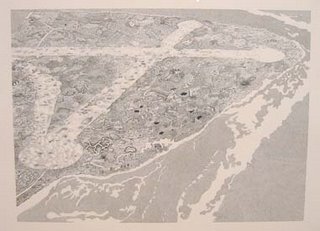 I previewed the Mills College MFA show and can recommend it to Bay Area art lovers. It’s a small show—there are only 12 graduates—but it’s rewarding. There will be a public reception on Sunday, April 30th, from 2:00 to 4:00 pm. The show, located in the Mills Art Museum, runs through May 28th.
I previewed the Mills College MFA show and can recommend it to Bay Area art lovers. It’s a small show—there are only 12 graduates—but it’s rewarding. There will be a public reception on Sunday, April 30th, from 2:00 to 4:00 pm. The show, located in the Mills Art Museum, runs through May 28th.I was much taken with the ink drawings by Nadol Pak. Of compact size, they bear a family resemblance to work by New York artists Jacob El Hanani and Daniel Zeller. But Pak is distinctive. He creates abstracted landscapes and cityscapes from a welter of small marks. The marks are highly inventive and reflect a background in cartooning. The drawings teem with them, although some drawings incorporate blank areas or quieter passages as breathing room. Space is flattened in a way that suggests Asian landscape painting. The density and size of the marks creates an internal scale that seems large. From a distance, though, the details of each drawing disappear and the work appears minimalist. This fusion of traditions with impish mark-making proves a winning combination. And the artist had the good sense to present his work in proper frames. I’m sure he’ll be taken up by a gallery shortly after he graduates, if not before. My camera is inadequate to capture work of such detail, but I have included one shot above, with apologies.
 Another artist who evokes delight using a small scale is Misako Inaoka. She has covered an extensive wall area with creatures whose DNA seem to have been scrambled against the rules. A red bird has a head of red berries. Two white birds are covered in growths that suggest camouflage among sea creatures. A yellow bird seems to grow from a knarly white root. These bird pieces are engaging, but they are uncomfortably close to the work of Los Angeles artist Carlee Fernandez. More distinctive were the many tiny creatures where the combinations seems less literal (detail above). Fellow artist Nadol Pak thought these look like toy prizes. They also might be menu items from a futuristic sushi bar.
Another artist who evokes delight using a small scale is Misako Inaoka. She has covered an extensive wall area with creatures whose DNA seem to have been scrambled against the rules. A red bird has a head of red berries. Two white birds are covered in growths that suggest camouflage among sea creatures. A yellow bird seems to grow from a knarly white root. These bird pieces are engaging, but they are uncomfortably close to the work of Los Angeles artist Carlee Fernandez. More distinctive were the many tiny creatures where the combinations seems less literal (detail above). Fellow artist Nadol Pak thought these look like toy prizes. They also might be menu items from a futuristic sushi bar. Diana Guerrero created a memorial to her father, who worked in a flower nursery in well-heeled Marin County where the workers’ only protection against pesticide sprays was paper masks. He died of stomach cancer in his early forties. Her installation combines family photographs with material from the now defunct nursery. In one section, an unnervingly sad photo of her father is hung above four decaying molds of a type of respirator that would have better protected him (photo above).
Diana Guerrero created a memorial to her father, who worked in a flower nursery in well-heeled Marin County where the workers’ only protection against pesticide sprays was paper masks. He died of stomach cancer in his early forties. Her installation combines family photographs with material from the now defunct nursery. In one section, an unnervingly sad photo of her father is hung above four decaying molds of a type of respirator that would have better protected him (photo above). Krishna Khalsa used hundreds of small pieces of wood to build a remarkable passage between the first and second rooms of the exhibition (detail above). She then added another outgrowth of this material in a corner, peeking over a wall. The effect was a delightful transformation of humble materials, and of space. Krishna also showed up for the preview in a terrific dress, purchased for $8 in a thrift shop (photo below).
Krishna Khalsa used hundreds of small pieces of wood to build a remarkable passage between the first and second rooms of the exhibition (detail above). She then added another outgrowth of this material in a corner, peeking over a wall. The effect was a delightful transformation of humble materials, and of space. Krishna also showed up for the preview in a terrific dress, purchased for $8 in a thrift shop (photo below).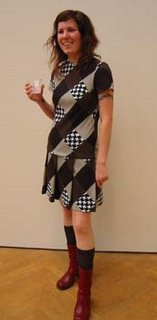 Amy Rueffert's presentation consists of shiny sculptures that are meticulously hand-made despite a factory look. They reference Modernist sculpture (and perhaps the ceramics industry) while trafficking in sexy bulges (detail below).
Amy Rueffert's presentation consists of shiny sculptures that are meticulously hand-made despite a factory look. They reference Modernist sculpture (and perhaps the ceramics industry) while trafficking in sexy bulges (detail below). A couple of other presentations are also of interest. Directions for getting to Mills via the freeway are posted on the college website.
A couple of other presentations are also of interest. Directions for getting to Mills via the freeway are posted on the college website.
Thursday, April 27, 2006
Art Market Note
In the New York Times today, Carol Vogel writes about the starry Manhattan art auctions coming up in May. These sales have been widely noted because the offerings include a cache of Donald Judd works from the Judd Foundation, an iconic Van Gogh, an early hand-painted Warhol soup can, and other significant works.
Vogel’s article includes two quotes that made me laugh (darkly) because they nail the market mindset these days. A representative from Christie’s described the current art market as “majestic.” Perhaps the next level will be…Titanic.? A representative of Phillips said, “People are inspired by the recent high prices.” Show of hands—do you feel inspired?
Vogel’s article includes two quotes that made me laugh (darkly) because they nail the market mindset these days. A representative from Christie’s described the current art market as “majestic.” Perhaps the next level will be…Titanic.? A representative of Phillips said, “People are inspired by the recent high prices.” Show of hands—do you feel inspired?
Wednesday, April 26, 2006
Scion Dashboard
 Recently I have received invitations to private receptions at the Scion Dashboard Gallery, a promotional effort by the car brand. The aim is to sell the brand to young people by associating it with artwork that looks young and preferably “street.” You know: graffiti, skulls, sci-fi, bad-ass language, and like that, bro. The San Francisco edition is happening in a temporary space in San Francisco’s Hayes Valley shopping district. The show will turn over 4 times in 4 weeks. I declined the party invitation but took a peek at week one. I knew there would be a Scion logo somewhere, but I had no idea that customize-your-Scion DVDs would be presented in trade-show fashion (photo above) or that a Scion car would be sitting in the center of the show, doors open.
Recently I have received invitations to private receptions at the Scion Dashboard Gallery, a promotional effort by the car brand. The aim is to sell the brand to young people by associating it with artwork that looks young and preferably “street.” You know: graffiti, skulls, sci-fi, bad-ass language, and like that, bro. The San Francisco edition is happening in a temporary space in San Francisco’s Hayes Valley shopping district. The show will turn over 4 times in 4 weeks. I declined the party invitation but took a peek at week one. I knew there would be a Scion logo somewhere, but I had no idea that customize-your-Scion DVDs would be presented in trade-show fashion (photo above) or that a Scion car would be sitting in the center of the show, doors open. The only art that registered at this viewing were some rap-like pieces by an artist whose name I didn’t get. One example shows a young Al Pacino talking tough about graffiti wars, it seems (photo above). Another one—it's good and punchy—shows the murdered rapper Biggie Smalls (photo below).
The only art that registered at this viewing were some rap-like pieces by an artist whose name I didn’t get. One example shows a young Al Pacino talking tough about graffiti wars, it seems (photo above). Another one—it's good and punchy—shows the murdered rapper Biggie Smalls (photo below).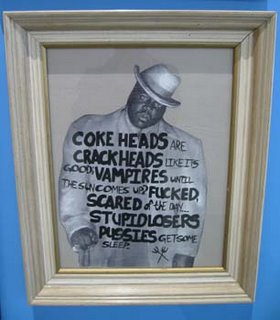 Unintended art moments in a completely different style were provided by some spotlighted displays of Scion parts (photos below). Shades of Haim Steinbach! I think my favorite is the one with the headrest, although the fog lights run a close second.
Unintended art moments in a completely different style were provided by some spotlighted displays of Scion parts (photos below). Shades of Haim Steinbach! I think my favorite is the one with the headrest, although the fog lights run a close second.

Art Chicago Reported in Disarray
Art Chicago, the major art fair in Chicago for the past 13 years, was scheduled to open on Thursday, April 27th. On Monday, the Chicago Tribune reported that the event was in disarray. Coverage by that paper continues. A good way to access this coverage is to use 'Art Chicago' as a search term in Google News.
In the past six months, the producer of this fair, Thomas Blackman Associates of Chicago, has made late-hour cancellations of two art fairs scheduled for San Francisco and New York. If the Chicago event collapses, the chances for another art fair under the Thomas Blackman banner would seem to be nil. To outsiders, it has appeared that Blackman was failing to adapt to the surge in popularity of competing U.S. art fairs, such as Art Basel Miami Beach and the Armory Show in NYC.
In the past six months, the producer of this fair, Thomas Blackman Associates of Chicago, has made late-hour cancellations of two art fairs scheduled for San Francisco and New York. If the Chicago event collapses, the chances for another art fair under the Thomas Blackman banner would seem to be nil. To outsiders, it has appeared that Blackman was failing to adapt to the surge in popularity of competing U.S. art fairs, such as Art Basel Miami Beach and the Armory Show in NYC.
Tuesday, April 25, 2006
New Exhibits This Week
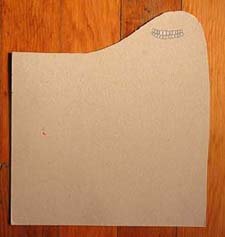 Starting today, Lincart opens a solo exhibit of Tucker Nichols, featuring drawings, sculpture, and an installation. Nichols has been a welcome presence in San Francisco’s non-profit art venues and has been shown by commercial galleries as well. His most recent New York show was in Chelsea at ZieherSmith Gallery. A few months ago, he did an excellent installation as part of a group show at Gallery 16 (SF). Lincart is located at 1632-C Market St., San Francisco (near Zuni Café). There is a reception for the artist on Thursday, April 27th, from 6:00 to 9:00 pm. (Image above from the gallery website.)
Starting today, Lincart opens a solo exhibit of Tucker Nichols, featuring drawings, sculpture, and an installation. Nichols has been a welcome presence in San Francisco’s non-profit art venues and has been shown by commercial galleries as well. His most recent New York show was in Chelsea at ZieherSmith Gallery. A few months ago, he did an excellent installation as part of a group show at Gallery 16 (SF). Lincart is located at 1632-C Market St., San Francisco (near Zuni Café). There is a reception for the artist on Thursday, April 27th, from 6:00 to 9:00 pm. (Image above from the gallery website.)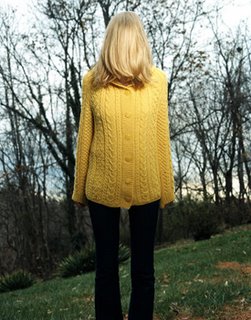 In the Inner Sunset district of San Francisco, Receiver Gallery opens a group photo show with a reception on Saturday, April 29th, from 7:00 to 10:00 pm. The address is 1314 8th Ave., near Irving St. The photo above is by one of the participants, Jessica Miller (image from gallery website).
In the Inner Sunset district of San Francisco, Receiver Gallery opens a group photo show with a reception on Saturday, April 29th, from 7:00 to 10:00 pm. The address is 1314 8th Ave., near Irving St. The photo above is by one of the participants, Jessica Miller (image from gallery website).Mills College in Oakland is opening its 2006 MFA show on Sunday, April 30th, from 2:00 to 4:00 pm. The show runs through May 28th. A dozen graduating artists will be presented. Mills has a strong art studio program, so this is a key event for people who follow the Bay Area art scene. Mills is located far into Oakland, but it’s not hard to find by freeway if you follow the directions provided on the college website.
“Elusive Materials” at New Langton (SF)
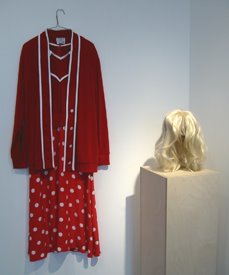 Another exhibition that closed on Saturday was “Elusive Materials” at New Langton Arts in San Francisco. This project was designed to show the work of artists “who have contributed to Langton’s history, and whose own practice involves an archival drive.”
Another exhibition that closed on Saturday was “Elusive Materials” at New Langton Arts in San Francisco. This project was designed to show the work of artists “who have contributed to Langton’s history, and whose own practice involves an archival drive.”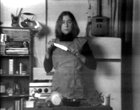 It was meant to be a conceptual show, and it was. Happily, two participants were well-known women artists who demonstrated that conceptualism needn’t be dry. In signature works from the 1970s, they underlined a common theme of the Women’s Movement of that era, “the personal is the political.” Martha Rosler’s famous 7-minute B&W video from 1975, “Semiotics of the Kitchen,” shows herself demonstrating everyday kitchen implements, as if she’s on a TV cooking show. She performs with a deadpan face and voice but with angry gestures. The piece retains its bite. A brief excerpt can be streamed from the artist’s website. (Image above is from Electronic Arts Intermix.)
It was meant to be a conceptual show, and it was. Happily, two participants were well-known women artists who demonstrated that conceptualism needn’t be dry. In signature works from the 1970s, they underlined a common theme of the Women’s Movement of that era, “the personal is the political.” Martha Rosler’s famous 7-minute B&W video from 1975, “Semiotics of the Kitchen,” shows herself demonstrating everyday kitchen implements, as if she’s on a TV cooking show. She performs with a deadpan face and voice but with angry gestures. The piece retains its bite. A brief excerpt can be streamed from the artist’s website. (Image above is from Electronic Arts Intermix.)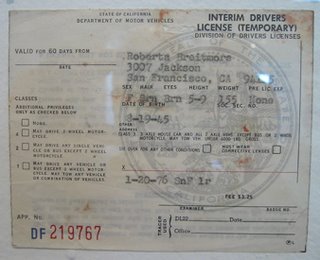 Stranger territory was explored by Lynn Hershman Leeson in a project that unfolded over most of the 1970s. The artist created the identity of a fictional person named Roberta Breitmore, using wigs, makeup, clothing, and altered behavior (photo at top). Roberta got a driver’s license (photo above), opened a checking account (photo below), qualified for credit cards, rented an apartment, placed classified ads to meet people, underwent a psychiatric evaluation, and so on. Eventually several other women (“multiples”) played Roberta as well. The presentation at New Langton is called “Roberta Breitmore’s Archive 1974-1978.” It includes the psychological evaluation (on letterhead), written in a dissociated style that was typical among psychiatrists but which seemed to echo the project’s creepy, fascinating investigation of identity.
Stranger territory was explored by Lynn Hershman Leeson in a project that unfolded over most of the 1970s. The artist created the identity of a fictional person named Roberta Breitmore, using wigs, makeup, clothing, and altered behavior (photo at top). Roberta got a driver’s license (photo above), opened a checking account (photo below), qualified for credit cards, rented an apartment, placed classified ads to meet people, underwent a psychiatric evaluation, and so on. Eventually several other women (“multiples”) played Roberta as well. The presentation at New Langton is called “Roberta Breitmore’s Archive 1974-1978.” It includes the psychological evaluation (on letterhead), written in a dissociated style that was typical among psychiatrists but which seemed to echo the project’s creepy, fascinating investigation of identity.
 Rosler and Hershman Leeson stole the show, but there were other works of some interest. James Tantum covered a huge wall with his obsessive hand-drawn personal calendars. On another wall, Allan Ruppersberg’s compact “Siste Viator” was installed. The Latin phrase, used on Roman tombstones, can be translated as “Pause, Wanderer” but is rendered as "Stop Traveler" for this piece. In appearance this work from 1993 is a small shelf of books in several languages, with dust covers that look old-fashioned but freshly printed (photo above left). The books are replicas made by the artist. Only an historical sleuth of considerable skill could discover the meaning of this work without a crib sheet. What you see are books that might have been read by young soldiers from four countries who fought the Battle of Arnhem in 1944. It is a memorial for the 8,000 who were killed. I think the piece is too clever by half, and why do the books look untouched? Still, once understood, the work leaves a trail in the mind.
Rosler and Hershman Leeson stole the show, but there were other works of some interest. James Tantum covered a huge wall with his obsessive hand-drawn personal calendars. On another wall, Allan Ruppersberg’s compact “Siste Viator” was installed. The Latin phrase, used on Roman tombstones, can be translated as “Pause, Wanderer” but is rendered as "Stop Traveler" for this piece. In appearance this work from 1993 is a small shelf of books in several languages, with dust covers that look old-fashioned but freshly printed (photo above left). The books are replicas made by the artist. Only an historical sleuth of considerable skill could discover the meaning of this work without a crib sheet. What you see are books that might have been read by young soldiers from four countries who fought the Battle of Arnhem in 1944. It is a memorial for the 8,000 who were killed. I think the piece is too clever by half, and why do the books look untouched? Still, once understood, the work leaves a trail in the mind.

Colter Jacobsen’s project was to re-create a version of his studio space. Lots of images and bits of text were arranged on one wall. One section (top photo immediately above) showed the frequent Jacobsen theme of pairing. The two packets of honey near the bottom make it clear that the artist is not talking about math. (Felix Gonzalez-Torres’s dual synchronized clocks are a favorite of this artist.) On the floor in front of the wall, a couple of boxes served as cubbyholes where personal materials are stored (bottom photo above). The temptation to root through these was strong, but I resisted.
 On the ground floor was an elaborate installation by Catalan artist Antonio Muntadas. It was his video work, “Between the Frames: The Forum.” Seven tiny video rooms were arranged side by side along an arc. The walls between the doorways suggested a colonnade around a public space. Multicolored lights bathed this structure, making it look (to me) like an opera set. The photo at right, taken from the New Langton website, shows a similar installation of the work at MIT.
On the ground floor was an elaborate installation by Catalan artist Antonio Muntadas. It was his video work, “Between the Frames: The Forum.” Seven tiny video rooms were arranged side by side along an arc. The walls between the doorways suggested a colonnade around a public space. Multicolored lights bathed this structure, making it look (to me) like an opera set. The photo at right, taken from the New Langton website, shows a similar installation of the work at MIT.In the video rooms, the screens presented an edited version of Muntadas’s 160 hours of interviews with art dealers, collectors, museum staff, critics, etc. The interviews were done in the 1980s and reflect the hype and greed of the 80s art market. There isn’t a section devoted to artists, although I understand the Epilogue includes a few artists talking. The total playing time for all the parts is 4 hours and 37 minutes.
The topic is historically interesting and highly relevant to the art market today, but the presentation undercuts individual voices by creating a Babel in which you can barely hear anything. The effect is intentional, but it’s frustrating. The piece looks inviting but then shuts you out. Transcripts of the videos were available for reference, but I wish they have been available to purchase.
Sunday, April 23, 2006
Galería de la Raza (SF)
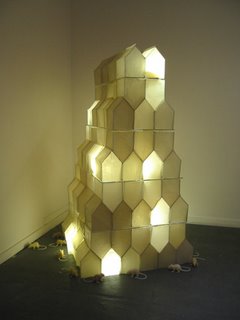 The “Mind Maps” exhibit at Galería de la Raza closed today, and I made it under the wire. It was a small show that allowed the very different types of artwork to inhabit their own spaces. The moment that caught my breath was when I turned a corner and saw Pilar Agüero-Esparza’s installation, “No Children Left” (2005, photo above). The title references the "no child left behind" slogan put forth by our non-education President. Yet the piece wasn't literal; it was evocative. Even the rats seemed poignant (detail, below).
The “Mind Maps” exhibit at Galería de la Raza closed today, and I made it under the wire. It was a small show that allowed the very different types of artwork to inhabit their own spaces. The moment that caught my breath was when I turned a corner and saw Pilar Agüero-Esparza’s installation, “No Children Left” (2005, photo above). The title references the "no child left behind" slogan put forth by our non-education President. Yet the piece wasn't literal; it was evocative. Even the rats seemed poignant (detail, below). Another sculpture that commanded it space was Hector Dio Mendoza’s “Habitat,” in which a trap full of dead bees hangs above a profusion of doily-like flowers (photo below).
Another sculpture that commanded it space was Hector Dio Mendoza’s “Habitat,” in which a trap full of dead bees hangs above a profusion of doily-like flowers (photo below). Using a barrio-wall aesthetic, Misty Avila Ovalles depicted a muscle man as the focal point for a medium sized painting that was worked from edge to edge (photo below).
Using a barrio-wall aesthetic, Misty Avila Ovalles depicted a muscle man as the focal point for a medium sized painting that was worked from edge to edge (photo below).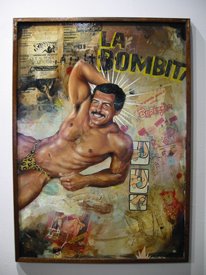 Garth Viera offered three drawings. My favorite was an untitled piece that seemed to depict a hobo couple at rest (photo below).
Garth Viera offered three drawings. My favorite was an untitled piece that seemed to depict a hobo couple at rest (photo below). One of the several paintings by Ana Teresa Fernandez seemed technically and conceptually better than the others (photo below). It shows the artist (I think) wearing a sexy black dress and matching heels to iron a garment, clean a floor, and hammer a nail. It seems to portray the labor behind moments of glamour, perhaps a metaphor for the life of an artist.
One of the several paintings by Ana Teresa Fernandez seemed technically and conceptually better than the others (photo below). It shows the artist (I think) wearing a sexy black dress and matching heels to iron a garment, clean a floor, and hammer a nail. It seems to portray the labor behind moments of glamour, perhaps a metaphor for the life of an artist.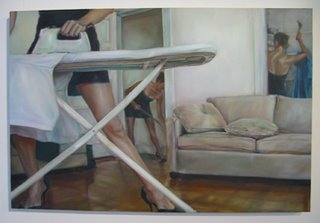
Friday, April 21, 2006
Armory Show, Day 2
 Here are some works I saw in March on my second day at this fair.
Here are some works I saw in March on my second day at this fair.London’s White Cube had a large booth in the center of things. High on one wall was a neon scrawl by Tracy Emin, “Everything for Love” (photo at top). It served as a snarky general comment on the fair. Also at White Cube were selections from the full set of Goya’s “Los Caprichos” etchings as re-worked by Jake and Dinos Chapman. The brothers, famous for their cheek, have collaged the Goyas by meticulously overpainting cartoony imagery on the figures. Mostly they have created replacement heads that look like Carnival or Halloween masks. Sort of a James Ensor effect. Unfortunately, the project comes across as a prank, offering shock value without content. If you didn’t know they were Goya prints, you’d shrug your shoulders and walk on. The prices were up to snuff, though: about $23,000 per print.
At D’Amelio Terras (NY), there was a terrific untitled sculpture by Heather Rowe. Made of metal and wood framing, with remnants of wood veneer, it looked like a folding screen that had been destroyed except for its framework. Strategically placed bits of mirror dematerialized the piece even further. Looking at it, you doubted your eyes. I decided the piece was too hard to photograph. Fortunately James Wagner didn’t—see the two shots on his blog.
 At China Art Objects (Los Angeles), I enjoyed seeing one of David Korty’s paintings (photo above). He depicts contemporary scenes with a sensibility that seems to draw on J.M.W. Turner, Monet, Cézanne, and Klimt. In his hands, even a garbage dump has become ravishing. Is this escapism? Is this critique? Maybe both at once, a love-hate thing.
At China Art Objects (Los Angeles), I enjoyed seeing one of David Korty’s paintings (photo above). He depicts contemporary scenes with a sensibility that seems to draw on J.M.W. Turner, Monet, Cézanne, and Klimt. In his hands, even a garbage dump has become ravishing. Is this escapism? Is this critique? Maybe both at once, a love-hate thing. Produzentengalerie Hamburg offered paintings by Norbert Schwontkowski. He’s a mid-career German artist whose cultivated informal style projects a tone somewhere between whimsy and black humor. Sometimes his work resembles illustrations for the New Yorker or for a sophisticated storybook. But these associations did not press forward with the works on view. I liked “Cine” (about 110 x 140 cm, photo above) and “Captain in Love” (about 60 x 40 cm, photo below), which depicts an officer caught in the web of love.
Produzentengalerie Hamburg offered paintings by Norbert Schwontkowski. He’s a mid-career German artist whose cultivated informal style projects a tone somewhere between whimsy and black humor. Sometimes his work resembles illustrations for the New Yorker or for a sophisticated storybook. But these associations did not press forward with the works on view. I liked “Cine” (about 110 x 140 cm, photo above) and “Captain in Love” (about 60 x 40 cm, photo below), which depicts an officer caught in the web of love.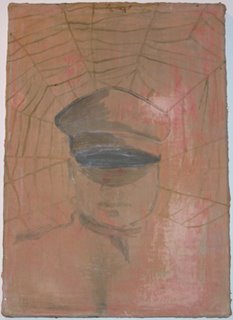 Transmission Gallery (Glasgow) had David Sherry’s 5-minute video, “Smashing Every Aspect,” showing the artist banging a metal tray against the corner of a table, over and over. He had masking tape covering his face, like a Jason horror mask. At White Columns (NY), San Francisco artist Colter Jacobsen’s drawings looked good, and they were hot sellers.
Transmission Gallery (Glasgow) had David Sherry’s 5-minute video, “Smashing Every Aspect,” showing the artist banging a metal tray against the corner of a table, over and over. He had masking tape covering his face, like a Jason horror mask. At White Columns (NY), San Francisco artist Colter Jacobsen’s drawings looked good, and they were hot sellers.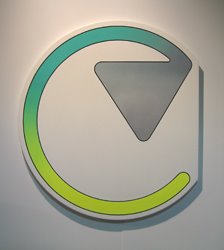 At Leo Koenig (NY), Greg Bogin offered a sardonic logo for the planet, painted using automobile lacquer on canvas. The piece, about 36" x 30", is called “The Late Great Planet Earth” (photo above).
At Leo Koenig (NY), Greg Bogin offered a sardonic logo for the planet, painted using automobile lacquer on canvas. The piece, about 36" x 30", is called “The Late Great Planet Earth” (photo above).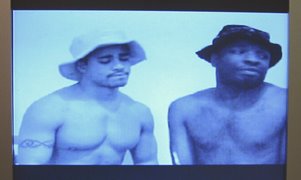 At Taxter & Spengemann (NY), Kalup Linzy’s video, “Lollipop,” was a hit. On a small monitor, Linzy and another man lipsync a blues song, the double-entendre kind, about whether the man is going to get his hands on Linzy’s “lollipop.” (Photo above.) This piece made camp seem fresh again. And it was technically stronger that Linzy’s videos in the “Frequency” show at the Studio Museum Harlem, a good sign.
At Taxter & Spengemann (NY), Kalup Linzy’s video, “Lollipop,” was a hit. On a small monitor, Linzy and another man lipsync a blues song, the double-entendre kind, about whether the man is going to get his hands on Linzy’s “lollipop.” (Photo above.) This piece made camp seem fresh again. And it was technically stronger that Linzy’s videos in the “Frequency” show at the Studio Museum Harlem, a good sign.Two other women artists caught my attention on Day 2. At Galerie Lelong (NY), I loved the dark Petah Coyne sculpture, "Untitled #1181 (Dante's Daphne)." Her work has an impact in person that photographs don’t seem to capture. At Wilkinson Gallery (London), I liked Joan Jonas’s B&W video from 1973, “Two Women,” a slowly rolling image of two women face to face.
Armory Show, Day 1
Here are some belated notes about the Armory Show, which I attended on March 10th and 11th.
This art fair, which started with 30 galleries at the Gramercy Hotel just 12 years ago, now presents nearly 150 galleries in two huge Manhattan piers. Sales are soaring, and one Los Angeles gallery owner described this fair as “the best in the past year.” For a viewer, though, the bigger the fair, the worse the experience. There are thousands of works to sort through, and the percentage of memorable work is staggeringly small. Entire countries, like France and South Korea, make a poor showing. Even if a work is decent, it can fade into the background. It's easy to miss things. I looked avidly, but came away with few photographs and not much longing. Here are some works I noticed on Day 1.
 At Matthew Marks, a little 8" x 12" painting by Ugo Rondinone was eye-catching in its modesty (photo above).
At Matthew Marks, a little 8" x 12" painting by Ugo Rondinone was eye-catching in its modesty (photo above).
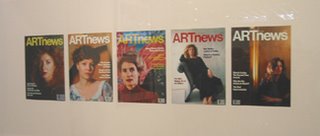 At Corri-Mora (London), a C-print by Anne Collier showed five 1980s issues of Art News featuring women on the cover (photo above). Collier, who was visiting the booth, said that she made the piece because she was fascinated by how the women presented themselves, especially the hair styles.
At Corri-Mora (London), a C-print by Anne Collier showed five 1980s issues of Art News featuring women on the cover (photo above). Collier, who was visiting the booth, said that she made the piece because she was fascinated by how the women presented themselves, especially the hair styles.
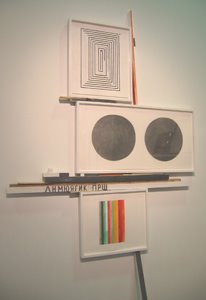 At Metro Pictures, there was an installation by Yuri Masnyj titled “This Ship Is Listing” (photo above). It carried out a de-Constructivist theme that was also explored in his work in the Whitney Biennial.
At Metro Pictures, there was an installation by Yuri Masnyj titled “This Ship Is Listing” (photo above). It carried out a de-Constructivist theme that was also explored in his work in the Whitney Biennial.
 Pierogi (Booklyn) had a bizarre (and amusing) piece by Tavares Strachan, “The Problem of One Thing Existing Simultaneously.” Inside a vitrine there were pieces of a shattered beer bottle, and lying next to each fragment was a duplicate (photo above, from the Pierogi website). At Peter Blum (NY), there was a beautiful orange/pumpkin monochrome painting by Joseph Marioni. In the Armory context, it looked so classical.
Pierogi (Booklyn) had a bizarre (and amusing) piece by Tavares Strachan, “The Problem of One Thing Existing Simultaneously.” Inside a vitrine there were pieces of a shattered beer bottle, and lying next to each fragment was a duplicate (photo above, from the Pierogi website). At Peter Blum (NY), there was a beautiful orange/pumpkin monochrome painting by Joseph Marioni. In the Armory context, it looked so classical.
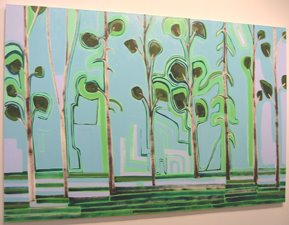 At Greenberg Van Doren (NY), a 48" x 72" oil painting by Benjamin Butler made me want to walk outside (photo above). All his paintings are based on trees.
At Greenberg Van Doren (NY), a 48" x 72" oil painting by Benjamin Butler made me want to walk outside (photo above). All his paintings are based on trees.
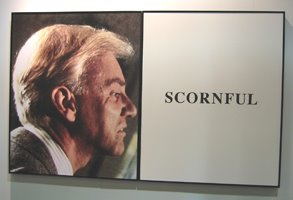 At Mai 37 Galerie (Zürich), I liked John Baldessari’s “Prima facie (Second State): Scornful.” It’s an archival digital print on canvas, about 77” wide (photo above).
At Mai 37 Galerie (Zürich), I liked John Baldessari’s “Prima facie (Second State): Scornful.” It’s an archival digital print on canvas, about 77” wide (photo above).
At 303 Gallery (NY), I noticed a trompe l’oeil work by Berlin-based British artist Ceal Floyer. A photo of a tiny nail sticking out from a white wall was slide-projected onto an actual white wall. The edges of the photo were darkened, vignette-style. (An interesting choice.) This piece could have been yours for just 35,000 Euros.
This art fair, which started with 30 galleries at the Gramercy Hotel just 12 years ago, now presents nearly 150 galleries in two huge Manhattan piers. Sales are soaring, and one Los Angeles gallery owner described this fair as “the best in the past year.” For a viewer, though, the bigger the fair, the worse the experience. There are thousands of works to sort through, and the percentage of memorable work is staggeringly small. Entire countries, like France and South Korea, make a poor showing. Even if a work is decent, it can fade into the background. It's easy to miss things. I looked avidly, but came away with few photographs and not much longing. Here are some works I noticed on Day 1.
 At Matthew Marks, a little 8" x 12" painting by Ugo Rondinone was eye-catching in its modesty (photo above).
At Matthew Marks, a little 8" x 12" painting by Ugo Rondinone was eye-catching in its modesty (photo above). At Corri-Mora (London), a C-print by Anne Collier showed five 1980s issues of Art News featuring women on the cover (photo above). Collier, who was visiting the booth, said that she made the piece because she was fascinated by how the women presented themselves, especially the hair styles.
At Corri-Mora (London), a C-print by Anne Collier showed five 1980s issues of Art News featuring women on the cover (photo above). Collier, who was visiting the booth, said that she made the piece because she was fascinated by how the women presented themselves, especially the hair styles. At Metro Pictures, there was an installation by Yuri Masnyj titled “This Ship Is Listing” (photo above). It carried out a de-Constructivist theme that was also explored in his work in the Whitney Biennial.
At Metro Pictures, there was an installation by Yuri Masnyj titled “This Ship Is Listing” (photo above). It carried out a de-Constructivist theme that was also explored in his work in the Whitney Biennial. Pierogi (Booklyn) had a bizarre (and amusing) piece by Tavares Strachan, “The Problem of One Thing Existing Simultaneously.” Inside a vitrine there were pieces of a shattered beer bottle, and lying next to each fragment was a duplicate (photo above, from the Pierogi website). At Peter Blum (NY), there was a beautiful orange/pumpkin monochrome painting by Joseph Marioni. In the Armory context, it looked so classical.
Pierogi (Booklyn) had a bizarre (and amusing) piece by Tavares Strachan, “The Problem of One Thing Existing Simultaneously.” Inside a vitrine there were pieces of a shattered beer bottle, and lying next to each fragment was a duplicate (photo above, from the Pierogi website). At Peter Blum (NY), there was a beautiful orange/pumpkin monochrome painting by Joseph Marioni. In the Armory context, it looked so classical. At Greenberg Van Doren (NY), a 48" x 72" oil painting by Benjamin Butler made me want to walk outside (photo above). All his paintings are based on trees.
At Greenberg Van Doren (NY), a 48" x 72" oil painting by Benjamin Butler made me want to walk outside (photo above). All his paintings are based on trees. At Mai 37 Galerie (Zürich), I liked John Baldessari’s “Prima facie (Second State): Scornful.” It’s an archival digital print on canvas, about 77” wide (photo above).
At Mai 37 Galerie (Zürich), I liked John Baldessari’s “Prima facie (Second State): Scornful.” It’s an archival digital print on canvas, about 77” wide (photo above).At 303 Gallery (NY), I noticed a trompe l’oeil work by Berlin-based British artist Ceal Floyer. A photo of a tiny nail sticking out from a white wall was slide-projected onto an actual white wall. The edges of the photo were darkened, vignette-style. (An interesting choice.) This piece could have been yours for just 35,000 Euros.
“Smart Ass” at Southern Exposure
 Southern Exposure’s recent exhibit was called “Smart Ass,” but I was a dumb-ass in neglecting to make a return visit. The day I saw the show, I needed to leave before watching Shannon Plumb’s videos or listening to the whole of Ben Riesman’s audio piece. I planned to go back and then blog about it in full. But I never made it.
Southern Exposure’s recent exhibit was called “Smart Ass,” but I was a dumb-ass in neglecting to make a return visit. The day I saw the show, I needed to leave before watching Shannon Plumb’s videos or listening to the whole of Ben Riesman’s audio piece. I planned to go back and then blog about it in full. But I never made it.The exhibit was curated by Kelsey Nicholson. One standout was Dustin Fosnot, a young artist whose playfulness immediately lifts your spirits. He often uses Styrofoam as a material and likes to make contraptions that move Styrofoam pellets around. The sculptures look like models for larger constructions in a science museum or an offbeat theme park. In one piece, a circle of small fans blows Styro-pellets around like drifting snow (photo below). In another, an Earth globe is torn open to reveal a column of slowly moving Styro-pellets under the watchful eye of a tiny figure in a protective suit (photo at top).
 Ryan Thayer reprised a couple of his signature works. One was a huge version of his ceiling tile walls, in which a wall looks like an office building ceiling—ceiling tiles, florescent light panels, air ducts. Another was his take on office cubicles (photo below, adapted from the artist’s website).
Ryan Thayer reprised a couple of his signature works. One was a huge version of his ceiling tile walls, in which a wall looks like an office building ceiling—ceiling tiles, florescent light panels, air ducts. Another was his take on office cubicles (photo below, adapted from the artist’s website). I sampled Ben Riesman’s self-help audio, “Visualize Sleeping Your Way to the Top.” It was presented complete with a comfy armchair. I regret not hearing the whole piece, as the sample was enticing. Both in script and voice it was precisely calibrated to sound genuine.
I sampled Ben Riesman’s self-help audio, “Visualize Sleeping Your Way to the Top.” It was presented complete with a comfy armchair. I regret not hearing the whole piece, as the sample was enticing. Both in script and voice it was precisely calibrated to sound genuine.
Thursday, April 20, 2006
“Instant Messaging” at Gallery 16
 If you're in San Francisco's Potrero District on weekdays, you can spend a happy half-hour sampling Gallery 16's show of informal communications on paper. It's a gathering of Post-It notes, sketches, postcards, notebook pages, lost-pet signs, and so on. Here are a couple of grids from the show:
If you're in San Francisco's Potrero District on weekdays, you can spend a happy half-hour sampling Gallery 16's show of informal communications on paper. It's a gathering of Post-It notes, sketches, postcards, notebook pages, lost-pet signs, and so on. Here are a couple of grids from the show: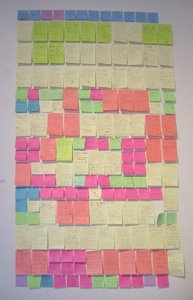
 Below, on a shelf, is a message missile from a prison in Russia, found by Nigel Poor. The tip of the missile is made of bread.
Below, on a shelf, is a message missile from a prison in Russia, found by Nigel Poor. The tip of the missile is made of bread.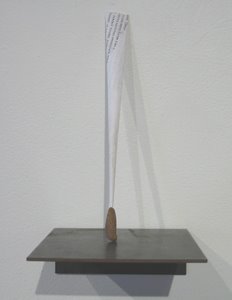 Here's a detail from a large drawing by Lauren Davies, prompted by the irritations of art fair participation:
Here's a detail from a large drawing by Lauren Davies, prompted by the irritations of art fair participation: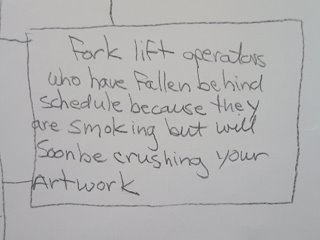 The show runs through May 12th. The gallery is open Monday through Friday, 9:00 am to 5:00 pm. The address is 1616 Sixteenth St. (third floor).
The show runs through May 12th. The gallery is open Monday through Friday, 9:00 am to 5:00 pm. The address is 1616 Sixteenth St. (third floor).
Stephan Pascher at Steven Wolf Fine Arts
 Since opening his own gallery space a year ago, Steven Wolf has offered exhibitions with a strong bent toward the conceptual. He likes art that invites discourse. He likes to relate new work to the history of conceptual art, about which he knows a good deal. The latest installment in this program is Stephan Pascher’s “Lucky Chairs 2002-2005, and other arrangements…” In the main space, five carousel slide projectors chug through 255 different images of institutional chairs that are leaned or stacked in precarious balances, like acrobats (photo above, from the gallery website). The chairs are posed in front of a wall, and shadows of their acrobatics add to the texture and reality of the images.
Since opening his own gallery space a year ago, Steven Wolf has offered exhibitions with a strong bent toward the conceptual. He likes art that invites discourse. He likes to relate new work to the history of conceptual art, about which he knows a good deal. The latest installment in this program is Stephan Pascher’s “Lucky Chairs 2002-2005, and other arrangements…” In the main space, five carousel slide projectors chug through 255 different images of institutional chairs that are leaned or stacked in precarious balances, like acrobats (photo above, from the gallery website). The chairs are posed in front of a wall, and shadows of their acrobatics add to the texture and reality of the images.The press release suggests that the tricky arrangements raise questions about authenticity in an age of digital manipulation. Well, perhaps. I was more interested in them as possible symbols of our rickety economic structure. But actually for me the overall effect of this installation was not ideas but a liberation from ideas. The chug of the projectors, located at the border between annoying and soothing, seems to disrupt thought. The insistent, unstable panorama of images has a Dada absurdity that lulls logic. I was sorry there weren’t actual chairs in the midst of all this, comfy ones, where a person could sit and zone out, perhaps sipping a cocktail or smoking hashish.
In the project room are some photographs of chair stacks, but these look badly framed. Another quibble is that the improvised pedestals for the projectors were unrewarding visually, despite their adherence to the procedure for this show.
Wednesday, April 19, 2006
Tonight: Danica Phelps at SFAI
Brooklyn artist Danica Phelps will give a talk tonight (April 19th) at San Francisco Art Institute. Her practice involves keeping detailed records of the financial and other aspects of her life and then using that documentation as a medium of exchange. The event is scheduled for 7:30 pm in the Lecture Hall at the 800 Chestnut St. campus.
Three Shows in the Mission (SF)
 If you’ve ever felt schizo, here’s the show for you. Mission 17 presents an exhibit of video and photography by young artist Mark Lee Morris, under the title “Mark v. Mark.” The artist plays TV game shows against himself, he attempts to bluff himself in a poker game, and he partners himself in modern dance poses (photo above, from the gallery website). Is this narcissism or a critique thereof? You be the judge. There is an opening reception on Friday, April 21st, from 6:00 to 9:00 pm. The location is 2111 Mission St., at 17th St., on the 4th floor.
If you’ve ever felt schizo, here’s the show for you. Mission 17 presents an exhibit of video and photography by young artist Mark Lee Morris, under the title “Mark v. Mark.” The artist plays TV game shows against himself, he attempts to bluff himself in a poker game, and he partners himself in modern dance poses (photo above, from the gallery website). Is this narcissism or a critique thereof? You be the judge. There is an opening reception on Friday, April 21st, from 6:00 to 9:00 pm. The location is 2111 Mission St., at 17th St., on the 4th floor.Not far away, at Artists’ Television Access, there is now a video in the window by an artist also claiming to be Mark Lee Morris. On the ATA website, he denounces the Mission 17 show. On the postcard for the Mission 17 show, he denies any involvement in the ATA show. Will a lawsuit be next? The ATA presentation runs through April 30th. The address is 992 Valencia St., at 21st St.
On April 7th, a small show called “Not for Sale” opened at Triple Base. Curator Nancy Meyer asked a few artists to lend favorite pieces from their own collections that were given or traded by other artists. There are good photos by Erik Seidenglanz (above top) and Roxanne Lowit, and also a vintage photo by Karlheinz Weinberger (above bottom, taken from Eyestorm site). Oliver Halsman Rosenberg did a mysterious wall installation, arranged in the form of a stick man, using materials from family life. Triple Base is the storefront at 3041 24th St., between Folsom and Harrison Sts.
 Finally, an offbeat little show of photography opened on April 14th at Arc Café, near Theater Artaud. It’s all about mistakes in photography, and it’s a good reminder that a mistake can be an opportunity. I stopped by before the lighting and the artist list were ready, but I managed one bad photo of Mariah Gartner’s two pieces (photo above) and noted interesting examples from Joshua Churchill and others. The café is on the corner of Mariposa St. and Florida St.
Finally, an offbeat little show of photography opened on April 14th at Arc Café, near Theater Artaud. It’s all about mistakes in photography, and it’s a good reminder that a mistake can be an opportunity. I stopped by before the lighting and the artist list were ready, but I managed one bad photo of Mariah Gartner’s two pieces (photo above) and noted interesting examples from Joshua Churchill and others. The café is on the corner of Mariposa St. and Florida St.
Subscribe to:
Posts (Atom)


